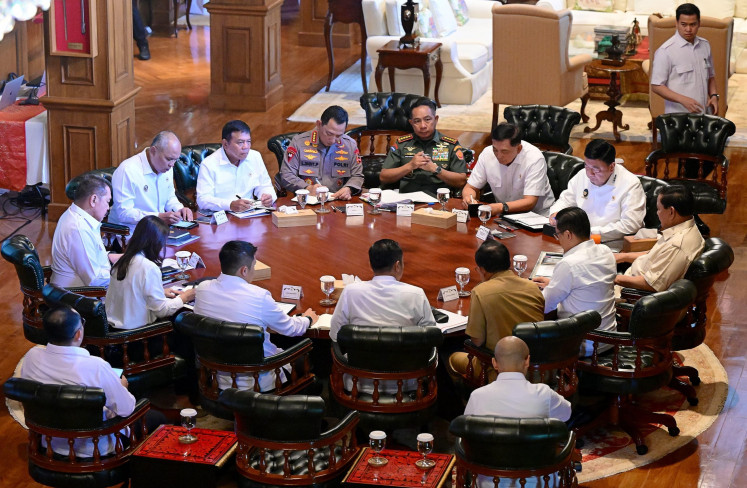Popular Reads
Top Results
Can't find what you're looking for?
View all search resultsPopular Reads
Top Results
Can't find what you're looking for?
View all search resultsASEAN, RI have a role in Preah Vhear dispute: Thai minister
Indonesia, as the holder of ASEAN’s current chair, recently hosted a brief foreign ministers meeting in Jakarta to help Cambodia and Thailand settle their heated border dispute over the Preah Vhear temple
Change text size
Gift Premium Articles
to Anyone
I
ndonesia, as the holder of ASEAN’s current chair, recently hosted a brief foreign ministers meeting in Jakarta to help Cambodia and Thailand settle their heated border dispute over the Preah Vhear temple.
Thai Foreign Minister Kasit Piromya spoke to The Jakarta Post’s Mustaqim Adamrah about how ASEAN is managing its new bilateral dispute mechanism. Below are excerpts from the interview:
Question: Why did Thailand accept a proposal to send Indonesian soldiers to the disputed border?
Answer: I think if there are no third parties [at Preah Vhear], then you could say that you shot first, or I shot first, and so on.
We have the experience of Thai military observers who were in Aceh and Timor Leste at the request of the Indonesian government. There’s nothing new here.
We agreed to have Indonesian Military observers, 15 members on each side of the border, to observe.
The other point is to help...the joint border committee [and the] ministers of defense of Thailand and Cambodia to meet.
I think Cambodia and Thailand have agreed to the resumption of bilateral negotiations.
I think it’s a recognition of the role and the ability of the ASEAN Community to settle disputes between countries. It means that…we will not have to burden the United Nations and the Security Council of the United Nations.
Thailand previously wanted to solve the dispute bilaterally without third party involvement. Do recent developments signal a change in Thai policy?
This is a bilateral solution. But I think it’s just like when you play tennis with two. You know you can have a referee, or have a doubles partner.
If we could go on bilaterally without having to trouble Indonesia, we would. But since at the moment we need the presence of Indonesia as facilitator, why not?
I don’t think [Thai policy] has changed. We even proposed bilateral negotiations, especially [for] the joint boundary committee. I think it was sometimes accepted, sometimes refused, by the Cambodian side.
In order to make it compatible with Cambodia, Indonesia will come to facilitate.
How will Thailand maintain the ceasefire?
There is no problem because I think from the very beginning we did not shoot first. And we don’t see any point to armed conflict. It’s nothing. At the end of the day, you have to come back to the negotiating table.
We are major exporter to Cambodia. We want to trade. We are becoming a more and more important investor. I think we have an obligation to ASEAN connectivity.
[The dispute] doesn’t make sense and at the same time we are providing a lot of assistance to Cambodia. We are a provider of development [support]. What’s the point of the conflict?
We don’t dispute [ownership of]the temple, but the land around the temple.
What’s the best solution to the dispute?
I think it has to be negotiations. I think we have a memorandum of understanding [MoU] between Thailand and Cambodia from the year 2000. In the memorandum of understanding it says which documents should be used as a basis for negotiations.
Take for example the treaties between Siam — the old name of Thailand — and the French colonial power in Thai-Indochina a hundred years ago, 1904-1907.
Some of the agreed minutes of the joint commission endorsed some of the maps made by the French.
All of these are documents that could provide a basis for further negotiations.
In fact we have been negotiating for a couple of years — six, seven, eight years already — and have made progress under the MoU.
For example, there were 73 border posts a hundred years ago. Now we have discovered 48 of them. You have to find the [remaining] 25.
Among the 48, we have verified half of them, the rest have yet to be verified.
So there’s progress and they are being suspended.
What we need now is for the joint border committee to resume. Then they [can] instruct the technicians to walk on the ground and go and find out where the [remaining] border posts are.










